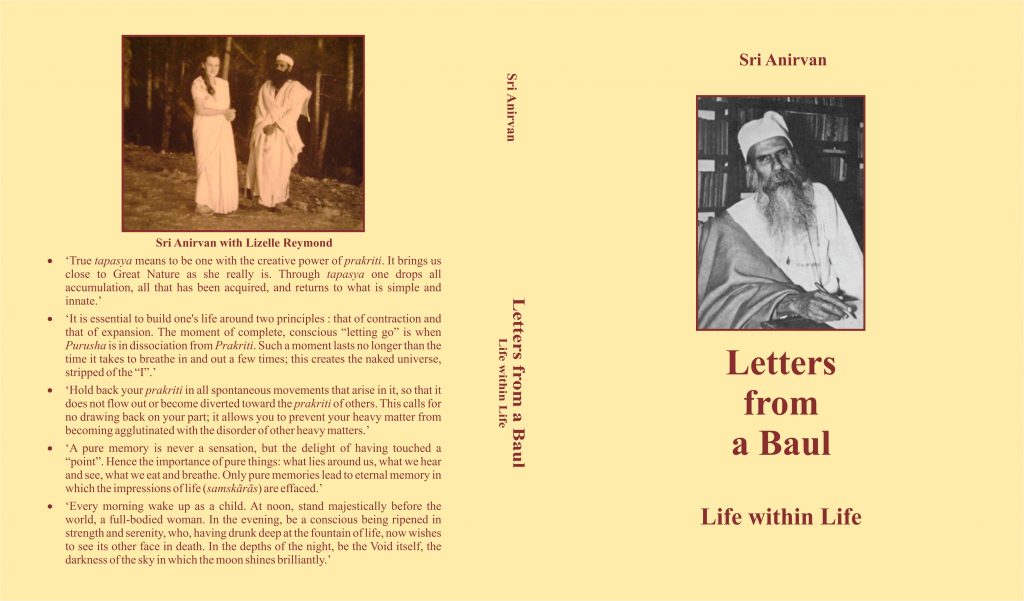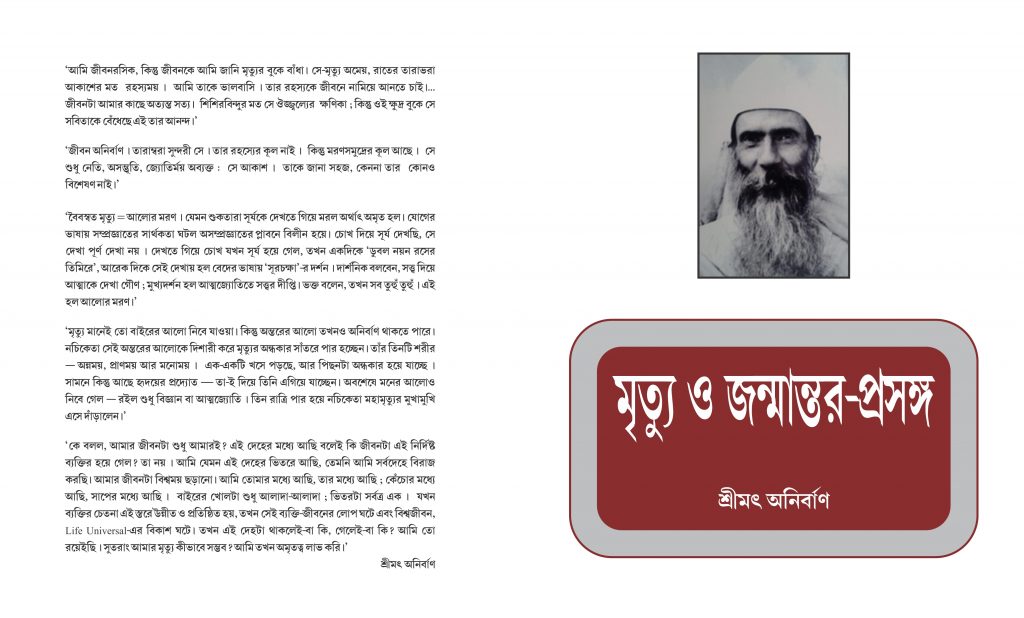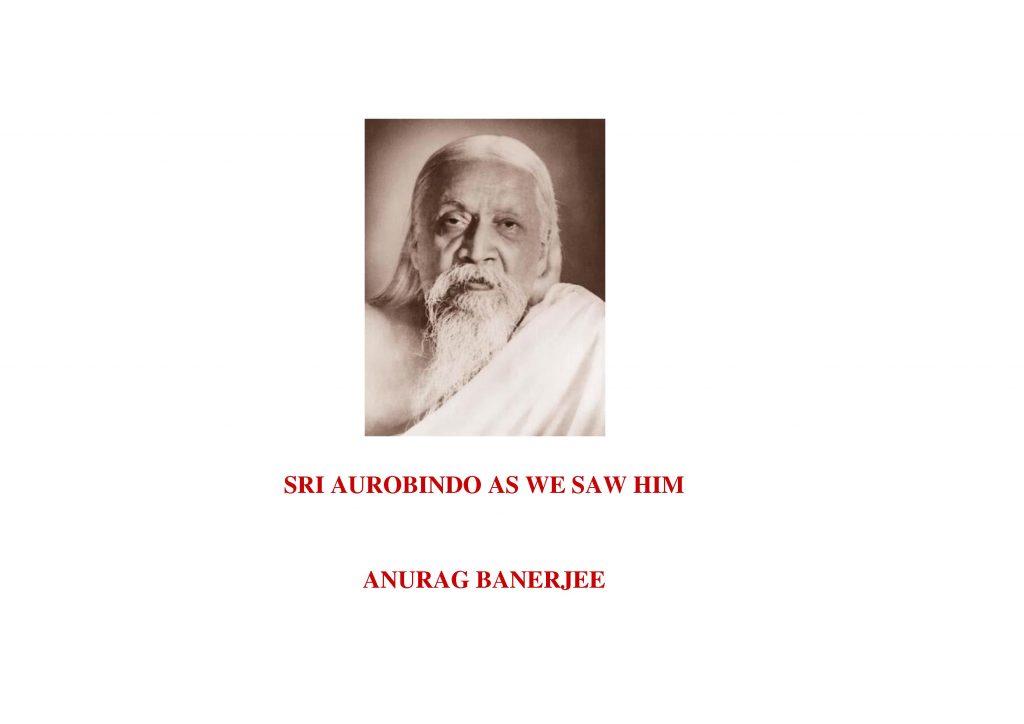Dear Friends and Well-wishers of Overman Foundation,
Shrimat Anirvan (8 July 1896—31 May 1978) had mastered the Astādhyayi of Pānini at a very early age. After completing his formal education he renounced the world and became Nirvanananda Saraswati. But after a few years he dropped the ochre robes and changed his name to Anirvan by which name he became known to the world at large. He spent a number of years in Lohaghat (Almora) where Madame Lizelle Reymond, a Swiss spiritual seeker, joined him and literally took him to the West through her books. He later shifted to Shillong in Assam and finally to Kolkata where he spent his last years. His first book was a Bengali translation of Sri Aurobindo’s The Life Divine which was described as a “living translation” by Sri Aurobindo himself and was published in two volumes between 1948 and 1951. Another sister-publication, Yoga-Samanvaya-Prasanga, based on Sri Aurobindo’s The Synthesis of Yoga, was published in 1961. According to Ram Swarup: “In translating Sri Aurobindo’s works, he was paying his debt to an elder brother and old friend from another life, as Shri Anirvan once said.” But the centre of his studies was the Vedas on which he acquired a rare mastery over the years. His other published works include his magnum opus, Veda Mimāmsā, (published in three volumes), Upanisad-Prasanga (three volumes on Īsa, Aitareya and the Kena), Gitānuvacana (three volumes), Vedānta Jijñāsā, Pravacana (four volumes) and several others.
On the occasion of Shrimat Anirvan’s 122nd Birth Anniversary, Overman Foundation has published two of his books titled Letters from a Baul and Mrityu O Janmantor Prasange (in Bengali).

Letters from a Baul is mostly based on the letters of Sri Anirvan and the recorded conversations which took place between him and Lizelle Reymond in Almora. The chapters classified as ‘A State of Sahaja’, ‘Sāmkhya’, ‘Laws-Powers’, ‘Masters and Disciples’, ‘Method and Teaching’, ‘Observation of Oneself’, ‘Automatism’, ‘Consciousness’, ‘Sensations’, ‘Emotions’, ‘Knowledge’, ‘Life-Death’, ‘Facing Reality’, ‘Rambling Thoughts’, ‘Sādhanā’, ‘Bauls of Bengal’ and ‘Mystic Songs’ provide a dimension of the author’s Sāmkhya-thought. Consisting of 236 pages, Letters from a Baul is available at a price of Rs. 300 (Three Hundred) only.

Mrityu O Janmantor-Prasange is an anthology of Shrimat Anirvan’s writings on Death and Rebirth. Consisting of 93 pages, this book is available at a price of Rs. 150.

First published in 2013, Sri Aurobindo As We Saw Him is a collection of interviews of twenty-seven individuals who have had the good fortune of seeing Sri Aurobindo and staying in Sri Aurobindo Ashram during His lifetime. It includes interviews of senior Aurobindonians like Noren Singh Nahar, Prof. Arabinda Basu, Pranab Kumar Bhattacharya, Nirmal Nahar, Suprabha Nahar, Sumitra Cazade, Kiran Kumari, Robi Ganguli, Robi Gupta, Gauri Pinto, Prof. Kittu Reddy, Vasanti Rao, Amita Sen, Kusum Nagda, Aniruddha Sircar, Dr. Aster Patel, Dhanavanti Nagda, Lata Jauhar, Shobha Mitra, Dr. Prithwindra Mukherjee, Jhumur Bhattacharya, Richard Pearson, Ranganath Raghavan, Parul Chakravorty, Bakul Sarkar, Bani and Dolly Mutsuddi. In this book, the interviewees have shared stories of how they came to stay at Sri Aurobindo Ashram, their enlightening reminiscences of Sri Aurobindo and some special anecdotes about Sri Aurobindo which they have either heard or personally witnessed. Some of them have also recounted their experiences of meeting Sri Aurobindo in the subtle physical.
Consisting of 326 pages, Sri Aurobindo As We Saw Him is available at a price of Rs. 375 (Three Hundred and Seventy Five) only.
Excerpts of reviews of Sri Aurobindo As We Saw Him penned by renowned Aurobindonian scholars are as follows:
Dr. Alok Pandey : ‘Indian thought recognizes two types of spiritual literature. One kind deals with the path and the processes. It is more impersonal and has a universal appeal. But in the process it becomes dry and appeals only to a certain portion of our being. Further it turns a living movement into an artificial and mechanical technique which is very far from the truth of things. Patanjali’s yoga sutras come into this category, a specialized codified process, marking each step of the journey but in the bargain losing the charm and grace of the unexpected that often walks close by with the sadhaka. The second type deals with the life and works, adventures and exploits, the joy of the Divine Being and His earthly lila. Mere reading of such a spiritual literature is uplifting. It lends wings to the soul, opens the shortest possible route to the Divine Contact through the secret heart, aligns our thoughts and will with the central aspiration, provides the much needed food for our spiritual parts. The Bhagavata, and the Ramayan belong to this class of literature. Some of course like the Gita combine the two approaches in a sublime synthesis. The book under review, Sri Aurobindo As We Saw Him, belongs primarily to this latter class of spiritual literature. However in the process it still provides us some glimpse of the path and the process. But even if it did not, its value will be immense and its gift priceless since mere reading of this book can uplift and illumine us and provide us with a glimpse of the embodied divinity, however indirect and mist-laden it may be because of a second person narrative.
‘Of course there is no dearth of accounts, even detailed accounts of the Darshan of Sri Aurobindo and the Mother and reminiscences and anecdotes of Their life. These are mostly accounts of first generation disciples who came in contact with Sri Aurobindo and the Mother in the first quarter of the previous century. Anurag’s book covers mostly the second generation disciples who came with their parents or else on their own but during the second half of the previous century. Some of these disciples came as children and grew up under the luminous wings of their Light and Love. In the consciousness of these disciples the human and the divine parents fused into one making a beautiful relation that was at once intimate as it was awesome. It is hard to say who was more fortunate, – the early disciples who came seeking for Yoga and saw in Sri Aurobindo and the Mother as the supreme Guide and Master, or those who came simply because some secret breath of Grace that took them as Their children…
‘There are also stories of more intimate encounters, stories that not only reveal immense Love, Patience and Compassion inspiring us to follow Their divinely-human example but also show us the deep care and concern that They have for those who have the rarest of privileges to be near Them…
‘These are some of the priceless pearls of Wisdom and Sacred treasure troves of invaluable gems of Love that the book contains. Critics will say that it is difficult to remain fully objective when we recount such experiences and there is always the possibility of some mixture. Well, may be, but then where can we find an absence of mixture anywhere in the world. And yet even if there is one golden grain of Truth in such accounts it is worth it. This book surely contains many such golden moments etched in the memory of the sadhakas. What is beautiful is that while reading through the accounts one clearly gets a feel that what is being stated is not more but less. The experiences are being understated rather than overstated. Where the memory is hazy or the experience unclear, the sadhakas are unwilling to narrate it, making this work unlike many other similar accounts. It will be an interesting document for posterity, not just for God-lovers who will always be delighted hear and read the accounts of disciples and the Lord’s dealings with them but also for scholars and spiritual historians who will find in the book firsthand accounts of some truly marvelous and interesting experiences.
‘Indeed the book is yet another jewel from Anurag’s pen and we wish that many more jewels follow.’
Dr. Prema Nandakumar : ‘Going through this fascinating collection, it is interesting how the disciple’s personality is reflected in his/her approach to Sri Aurobindo. Even more fascinating are the brief biographical notes on the interviewees. They come from varied background situations, some because of their parents, others because of a chance meeting with a devotee or an article… Was it all absolutely heavenly in the Ashram, as for instance, we find in the House of New Creation in Savitri? Obviously not. There were arrivals and departures, short-sighted statements, deliberate misrepresentations, the injudicious dance of human ego. This is what makes the Ashram life natural; after all, this was a laboratory of the future in the making! … Expectedly, there is more of “Mother as we saw Her” than of Sri Aurobindo. This too is understandable for he was in seclusion, busy with his yoga and communing with his disciples through letters. Yet, there are many here who give us a fine picture of the Master to draw us closer to Sri Aurobindo’s personality.Though it was the Mother whom they saw often, Sri Aurobindo’s presence was inescapable…
‘We see Sri Aurobindo and the Mother as a brilliant haze watched through the shimmering veils of memory in the hearts of devotees, always a delightful experience. Anurag does bravely try to get some solid material, by his questions but they keep their distance like the Supermind!… There lies the charm of this book. No two answers are alike. This experience of living in the presence of the Mother and Sri Aurobindo was certainly an extraordinary one and contained continents. For the interviewees in this book, it is a continuing experience. Perhaps Anurag’s persistence to know when Sri Aurobindo and the Mother would return gets answered silently. Where is the question of a return? They are already here! Strong, heroic souls all, these twenty-seven stars shed the Aurobindonian light for us as a clear statement of faith.’
Dr. Larry Seidlitz : ‘The book is a delight to read, especially for those familiar with the Ashram and the contributors. I felt transported back to the early days of the Ashram and got a feel for the atmosphere it had back then. I enjoyed the book as much for the insights it gives into the lives of the interviewees as for the glimpses it provides of Sri Aurobindo and the Mother. While some of the author’s questions were individually targeted or probed deeper into particular responses, many were uniformly asked of each respondent. While some of the latter questions provided an open platform for the interviewee to share their recollections, a few seemed too narrowly-focused and yielded few new insights. In general I found the writing and presentation well done, flowing… For those who are interested in stories of the former Ashram days when Sri Aurobindo and the Mother were here and interacting with the disciples, this book is a treasure trove. Anurag has brought together many beautiful gems in this delightful work which remind us of the true spirit of the Ashram and its life in its earlier years.’
For further details, kindly click on the following link:
http://overmanfoundation.org/our-publications/
To place an order, kindly write to us at: overmanfoundation@gmail.com and overmanfoundationoffice@gmail.com, or call us at : (0) 9830244192 and (0) 9874011224.
With warm regards,
Anurag Banerjee
Founder,
Overman Foundation.